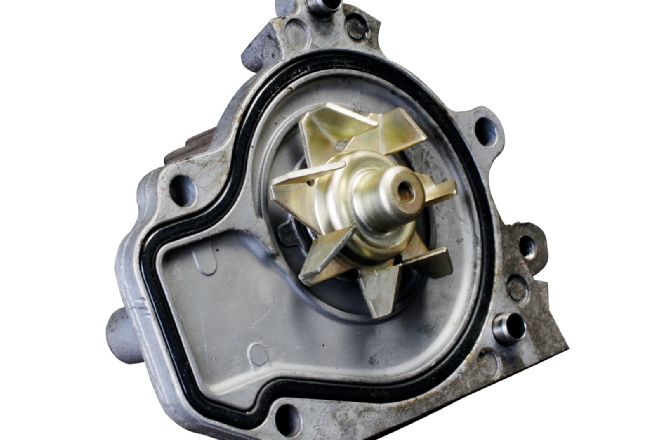Technical
Like any internal combustion engine, your Honda gets hot. Really hot. You might not be surprised to hear that its exhaust gas temperatures reach upwards of 1,500 degrees F, but did you know that its peak combustion chamber temperatures are much hotter, often reaching well over 5,000 degrees F? It's your cooling system's job to allow your engine to reach its operating temperature as quickly as possible but to also keep those 5,000-degree F chamber temps from obliterating the rest of what's under your valve cover.
As your engine cycles, its cooling system removes heat from its cylinder head(s) and cylinder walls. A well-thought-out cooling system-like Honda's-will only dissipate what's necessary. Although running too cool won't destroy an engine like overheating will, it isn't ideal. An overly cool engine can prematurely wear internal components, is less efficient, and is more pollutant. Its lubrication system will also be less effective since its engine oil won't reach its full operating temperature, which can compromise its viscosity. Problem is, even though gasoline engines like Honda's have improved dramatically over the years, they're still not all that efficient at converting chemical energy into mechanical power. Most of the energy in the fuel you use is converted into heat instead of horsepower. It's your cooling system's job to figure out what to do with all of it.
The process isn't terribly complex. It starts with a belt-driven water pump that pushes about six or seven quarts of coolant (typically a mixture of water and some sort of antifreeze) through the engine block and around the cylinders where it absorbs heat. Coolant then flows through passages that correspond with the cylinder head, past the thermostat housing, through a series of tubes and hoses, and into the radiator through its upper port where heat is released to the outside air. Once coolant exits the radiator's lower port, it's directed back toward the water pump to start all over. In some cases, individual circuits may direct fluid from the cylinder head into a heater core, engine oil cooler, or transmission oil cooler before routing it back to the water pump. An electric or belt-driven fan attached to the radiator's core helps temperatures remain consistent while idling or during stop-and-go traffic. The process repeats itself, over and over, with temperatures fluctuating by as much as 15 degrees F as the mixture makes its way from the engine block to the radiator.
The Coolant
Nothing will cool your engine better than plain old water. Distilled water is best but any drinking water free of minerals will work. However, plain water can lead to corrosion, and for those in colder climates, can freeze. Instead, a mixture of coolant, water, and anti-corrosion additives is used. Coolant is basically ethylene glycol, also known as antifreeze. Add it to water and its boiling and freezing points both improve. Coolant does what water can't: function effectively at below-freezing temperatures as well as those higher than 100 degrees F; it even prevents corrosion. It has a low freezing point but a high boiling point. It can also capture a significant amount of heat.
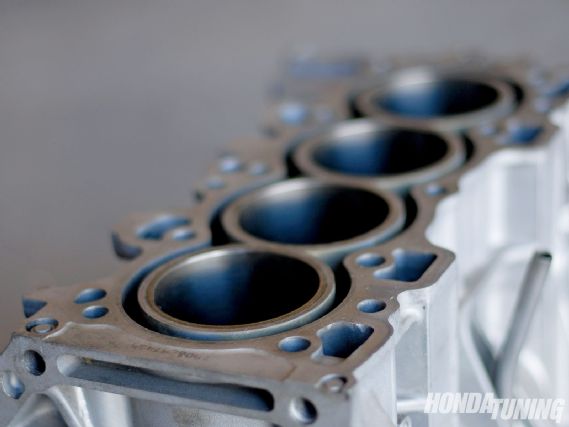 |
Coolant flows through the engine block, around its cylinders where it absorbs heat, and through special passages that correspond with its cylinder head(s). How well it does this is directly proportional to the longevity of your engine.
|
Coolant flows through the engine block, around its cylinders where it absorbs heat, and through special passages that correspond with its cylinder head(s). How well it does this is directly proportional to the longevity of your engine.
Every cooling system requires a certain amount of fluid, which can be identified in your car's service manual. Common indicators of a low coolant level include overheating and an inconsistent heating (climate control). Honda manufactures its own pre-mixed coolant. It's not much more expensive than what you'll get at the auto parts store and includes all of the corrosion-inhibitors that you need. Buy it. Use it.
The Water Pump
Honda water pumps are driven by their crankshafts. A typical water pump is little more than a centrifugal pump with an impeller that pulls coolant into the block while the engine runs. Centrifugal force pushes the coolant outward so it's discharged at the tips of its impeller. This allows fluid to flow toward its center continuously and prevent cavitation. It does all of this without increasing the system's pressure (any pressure increase is due to heat alone). As engine speed increases and heat rises, the water pump spins faster, increasing the flow of coolant that's pumped through the engine. Different engines feature water pumps with different sized pulleys, allowing for the proper ratio between the pump and the crankshaft pulley for proper flow.
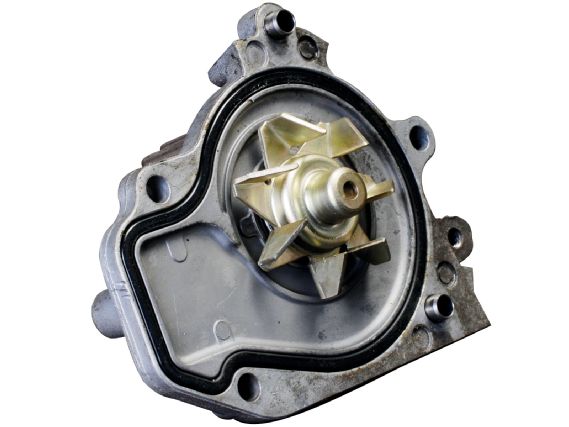 |
Your water pump is little more than a centrifugal pump with an impeller that pulls coolant into the engine block. Centrifugal force pushes coolant outward so it's discharged at the tips of its impeller. This allows fluid to flow toward the water pump's center continuously and prevent cavitation.
|
Your water pump is little more than a centrifugal pump with an impeller that pulls coolant into the engine block. Centrifugal force pushes coolant outward so it's discharged at the tips of its impeller. This allows fluid to flow toward the water pump's center continuously and prevent cavitation.
Over time, your water pump will corrode, resulting in a less efficient impeller. Water pumps can also leak. Both will result in overheating and potential engine damage. It's best to replace the water pump any time the timing belt is serviced, as it's a simple procedure once you're already in there.
The Thermostat
Honda engines like to operate somewhere around 200 degrees F; the thermostat helps make sure this happens. Thermostats are little more than temperature-sensitive valves located at the port closest to where coolant exits the engine. Before engine temperatures reach 180 degrees F, the thermostat remains closed, preventing the coolant mixture from passing through itself, and then the radiator, and being cooled off. It begins opening at about 180 degrees F, fully opening at about 200 degrees F. Without one, your engine will take abnormally long to warm up and will likely run too cool. Failure to reach an engine's optimum operating temperature can lead to excessive hydrocarbons and less-than-optimal combustion. That's why it's important to get your engine up to operating temperature (hotter, if possible) prior to any emissions test. Although unlikely, a bad thermostat can lead to overheating, but is almost always the culprit when the problem is an engine that runs too cool. The thermostat is pretty simple: its cylinder-shaped portion is filled with temperature-sensitive wax that melts at about 180 degrees F. As the wax expands, it extends a small rod connected to the valve, opening the thermostat and allowing coolant to pass through.
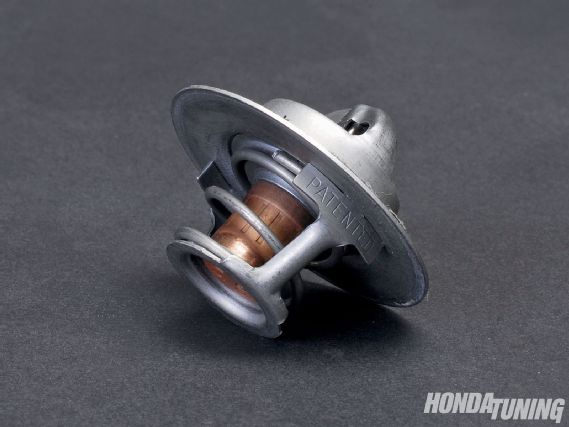 |
Thermostats are little more than spring-loaded, temperature-sensitive valves that help your engine warm up as quickly as possible and operate at its proper temperature.
|
Thermostats are little more than spring-loaded, temperature-sensitive valves that help your engine warm up as quickly as possible and operate at its proper temperature.
The Radiator
Your radiator is just a big heat exchanger, like an intercooler, only not as glorified. Its job is to transfer heat from the coolant to the air that blows past itself. Most radiators are made from aluminum, which is, for the most part, corrosion-resistant and has exceptional heat-transferring characteristics. The two most common types of radiators are "serpentine fin core" and "plate fin core." Both types introduce coolant through an inlet that allows it to flow through tubes arranged in parallel before exiting out the other side. Most designs also incorporate tanks at each end. Heat transfers through its tube walls and soldered joints to its fins, which are exposed to airflow. It's the airflow that removes the heat from the radiator, not the coolant.
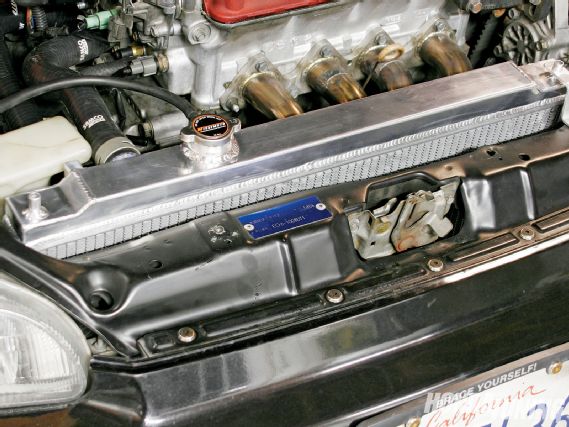 |
Your Honda's radiator is simply a heat exchanger that transfers the heat that your engine produces to the air around it.
|
Your Honda's radiator is simply a heat exchanger that transfers the heat that your engine produces to the air around it.
Your radiator must be capable of removing the amount of heat energy equal to the amount of heat energy your engine produces in power. For example, each horsepower your engine produces is equal to approximately 42 BTU, so if you do an engine swap or significantly increase power output, well, you've got to increase your engine's cooling capacity. A larger radiator is the best place to start.
The Overflow Reservoir
Actually, this should be called a coolant recovery system, not an overflow. Every cooling system is under some sort of pressure. As heat rises, pressure builds, which means the coolant needs some place to go. The overflow reservoir (typically a plastic container located near the radiator) takes on this extra coolant when the engine is hot and the mixture expands. Once the engine cools down and pressure decreases, a slight vacuum is created within the system, redirecting excess coolant back into the radiator, keeping the system full. Without some sort of sealed overflow tank, you'll lose coolant each time the system pressurizes, ultimately dropping to a dangerously low level.
When diagnosing an overheating problem, be sure and check the radiator fluid level, not the overflow tank's. If there are any small leaks in the system (hoses, water pump, etc.), then a vacuum strong enough to pull excess fluid out of the overflow container will never be created, thus giving you the illusion that your system is full.
The Radiator Cap
Your radiator or overflow tank incorporates some sort of sealed pressure cap. As temperatures rise, coolant expands, creating pressure. Once cooling system pressure reaches whatever the cap's spring is set to (usually about 15 psi), its valve is pushed open, releasing pressure and excess coolant into the reservoir for later recirculation. The cap continually opens and closes its spring to keep the system's pressure consistent. The pressure that the cap determines also helps raise the coolant's boiling point by about 3 degrees F for every 1 psi of pressure. Similar to how water boils at a higher temperature in a pressure cooker, coolant boils at a higher temperature when the system's pressure increases. For example, at sea level, water boils at 212 degrees F, however, with a 15 psi pressure cap, water boils at 257 degrees F. With the right coolant mixture and high-pressure cap, boiling points well over 270 degrees F are typical, which is hotter than any engine should ever operate.
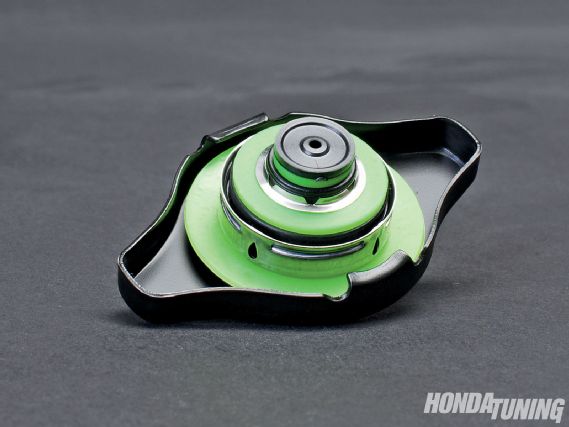 |
Your radiator cap continually opens and closes its spring to keep your cooling system's pressure consistent and raises its boiling point for more effective cooling.
|
Your radiator cap continually opens and closes its spring to keep your cooling system's pressure consistent and raises its boiling point for more effective cooling.
Interestingly enough, something as simple as a radiator cap can also cause your water pump to malfunction. In order for your water pump to work effectively, its inlet side must operate at a lower coolant pressure than its outlet side. If inlet pressure is too low, though, the coolant can boil before entering the pump, allowing only vapor to circulate inside. It's called "pump cavitation" and its often caused by an incorrect radiator cap. Radiator hoses that collapse once the engine has cooled down are another sign of a faulty or incorrect radiator cap that creates too strong of a vacuum within the system. Before replacing your radiator cap, be sure it's rated, pressure-wise, for your application. Typically, anywhere from 13-19 psi is acceptable for most Honda engines.
The Cooling Fan
Generally speaking, a larger or higher-flowing radiator fan will only improve cooling while idling or during stop-and-go driving, that's why your cooling fan only turns on while idling or during stop-and-go traffic. If you're experiencing cooling problems under those conditions, check the fan or for radiator blockages. If you're experiencing problems during high speeds, check for some sort of coolant circulation problem, like the water pump or a clogged radiator.
Similar to thermostats, cooling fans must be controlled in order to keep temperatures consistent. Most Honda fans are controlled by thermostatic switches that deliver power once the engine reaches a certain temperature and shuts them off once it cools.
Bleeding The System
Any time the cooling system is drained and refilled, small air pockets can present themselves. They need to be prevented in order for the system to function effectively. To bleed the system and ensure it's air-bubble-free, open your engine's bleeder valve while filling the system and slide your climate control's temperature control lever to maximum heat. Tighten the bleeder valve once coolant dribbles out in a steady stream.
To eliminate air pockets once the system is already full, loosen the bleeder valve or radiator cap halfway and drive the vehicle until it reaches its operating temperature. With the cap loose, pressure won't be able to form in the system. Be sure to drive the car thoroughly to allow the coolant mixture plenty of time to circulate. Any air bubbles will escape past the cap. Be sure to top off the system when finished. Failure to bleed the system properly will result poor heating (climate control) and possible engine overheating.

